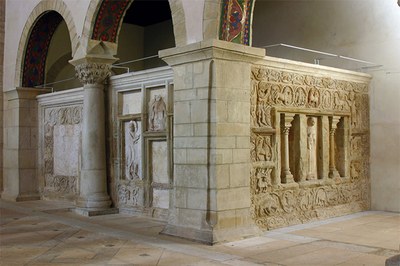Matthew Sova // Reconstructing the Tomb of Christ: Authenticity and Performance in Medieval Holy Sepulchers
Between the fifth and thirteenth centuries, over one hundred reconstructions of the tomb of Christ were built throughout Europe. Described as ‘Holy Sepulchers,’ ‘Easter Sepulchers,’ or ‘tombs of Christ’ in medieval texts, these objects and sites vary widely in design, dimension and complexity. Regardless, scholarship on these reconstructions emphasizes a common architectural reliance on the Church of the Holy Sepulcher in Jerusalem. This approach, which highlights the imperfect, symbolic, or invocative copying of this illustrious model, minimizes the numerous strategies of authentication present in these objects and sites, such as the embedding of relics, the addition of painted and sculpted programs, and the paraliturgical performances staged in and around these structures.  These strategies invest tomb of Christ reconstructions with authenticity, defined in this project as a claim or series of claims to holy origin and contemporaneous sanctity that elevates the status of these structures beyond that of inadequate reproduction. My dissertation investigates these authenticating claims in tomb of Christ reconstructions, deemphasizing the architectural prototype of the Jerusalem Church in favor of a network of liturgical, monastic, and artistic traditions present in Western Europe, Byzantium, and the Near East. With this broad geographic scope, my project explores not only the regions of Germany, Italy, France, England, and Switzerland often favored in scholarship, but also historical regions commonly treated as peripheral in medieval art history, such as the Spanish frontier, Pre-Conquest England, Eastern Europe, and the Caucasus in order to discover the diverse textual, artistic, and architectural sources for these structures. Problematizing notions of model and copy, center and periphery, I argue that medieval tomb of Christ reconstructions are universally engaged with concerns about their authenticity, the key component in their efficacy as sites of conversion, political messaging, pilgrimage, and performance.
These strategies invest tomb of Christ reconstructions with authenticity, defined in this project as a claim or series of claims to holy origin and contemporaneous sanctity that elevates the status of these structures beyond that of inadequate reproduction. My dissertation investigates these authenticating claims in tomb of Christ reconstructions, deemphasizing the architectural prototype of the Jerusalem Church in favor of a network of liturgical, monastic, and artistic traditions present in Western Europe, Byzantium, and the Near East. With this broad geographic scope, my project explores not only the regions of Germany, Italy, France, England, and Switzerland often favored in scholarship, but also historical regions commonly treated as peripheral in medieval art history, such as the Spanish frontier, Pre-Conquest England, Eastern Europe, and the Caucasus in order to discover the diverse textual, artistic, and architectural sources for these structures. Problematizing notions of model and copy, center and periphery, I argue that medieval tomb of Christ reconstructions are universally engaged with concerns about their authenticity, the key component in their efficacy as sites of conversion, political messaging, pilgrimage, and performance.
[Caption: Holy Sepulcher, Stiftskirche Sankt Cyriakus, Gernrode, late 11th century. (Image Credit: Katja Orthen, Evangelische Kirchengemeinde Gernrode.)]
